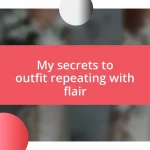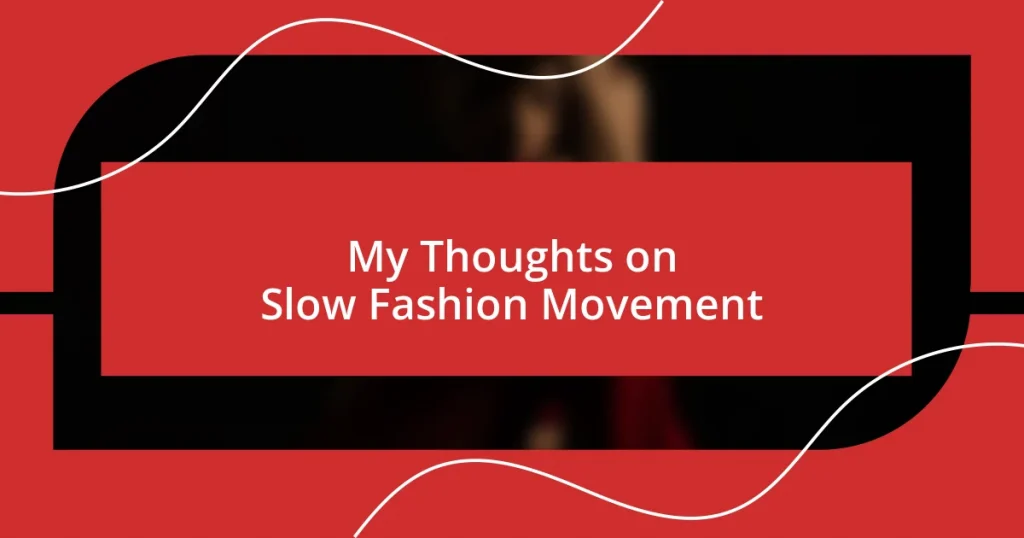Key takeaways:
- Slow fashion emphasizes quality over quantity, encouraging mindful purchasing and emotional connections to clothing.
- Supporting sustainable brands and local artisans fosters community, promotes ethical practices, and enriches personal style.
- Caring for clothes through gentle washing, mending, and proper storage extends their lifespan and deepens the wearer’s connection to their wardrobe.
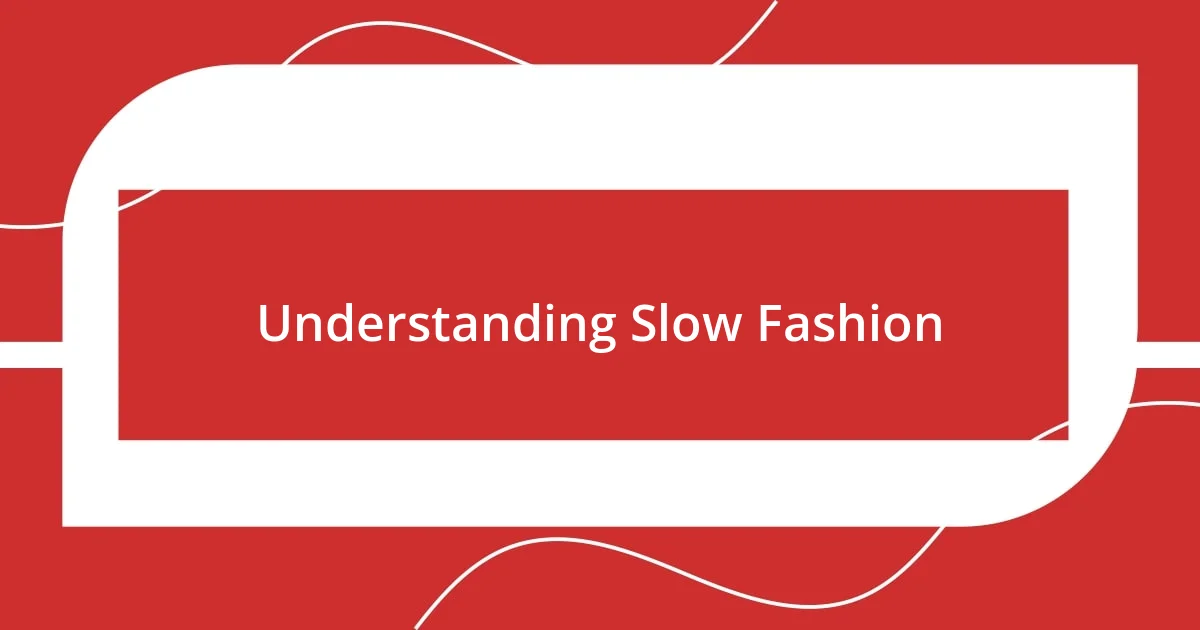
Understanding Slow Fashion
Slow fashion is all about valuing quality over quantity. I remember when I first realized the impact of my shopping choices; I had a wardrobe full of trendy pieces that I hardly wore. It struck me that I’d rather invest in a few high-quality items that last than chase fleeting fashion trends that quickly lose their appeal.
At its core, slow fashion encourages us to consider the lifecycle of our clothing. Have you ever stopped to think about where and how your clothes are made? I did, and it opened my eyes to the countless labor hours and resources that go into creating each garment. Understanding this not only deepened my respect for artisans but also made me more mindful about my purchases.
The emotional connection with our clothing also shifts in slow fashion. When I acquired a beautifully crafted sweater from a local artisan, it began to feel like a cherished heirloom rather than just another item. Isn’t it fascinating how the stories behind our clothes can enrich our experience of wearing them? It transforms shopping from a mindless task into a meaningful journey.
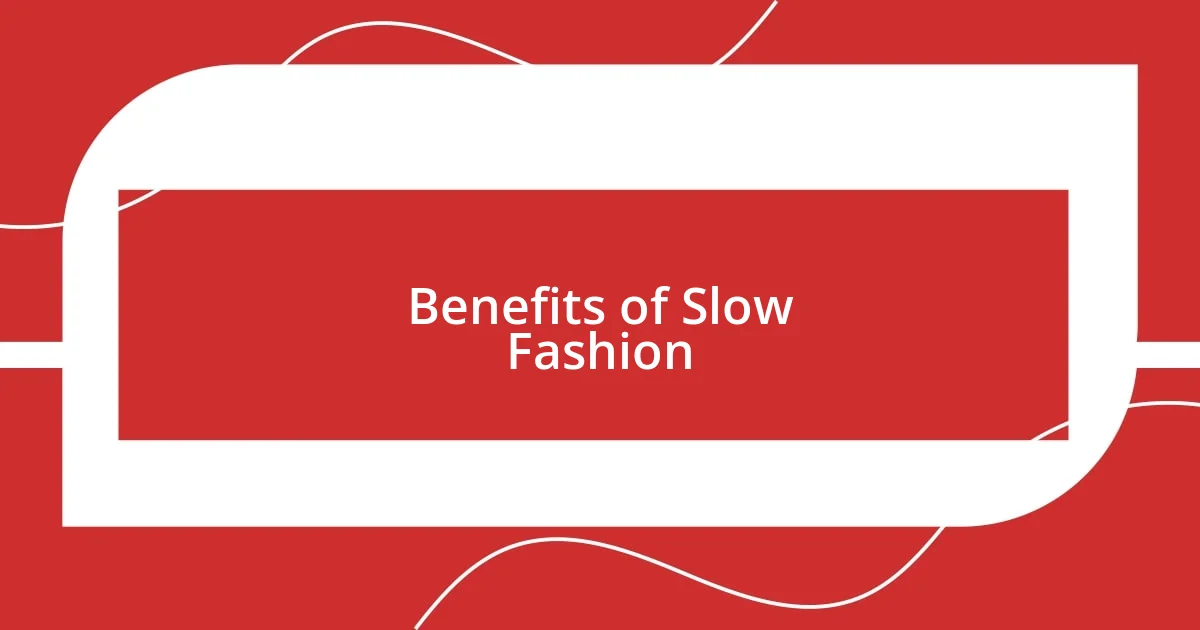
Benefits of Slow Fashion
The benefits of slow fashion are numerous and truly transformative. Personally, I’ve found that investing in fewer, higher-quality items not only elevates my style but also fosters a sense of pride in my wardrobe. Each piece tells a story, making getting dressed a more personal experience. When I wear a dress crafted from sustainable materials, I often catch myself sharing its journey with friends, and it sparks conversations about quality versus quantity—a dialogue I find so rewarding.
Here are some key benefits I’ve observed:
- Sustainable Practices: Slow fashion supports environmentally-friendly production methods, reducing waste and pollution.
- Quality Over Quantity: Investing in durable items results in longer-lasting pieces, ultimately saving money over time.
- Support Local Artisans: Purchasing from local artisans strengthens communities and embraces unique craftsmanship.
- Meaningful Consumption: Each purchase carries a story, leading to a deeper emotional connection with our clothing.
- Less Stress: A curated wardrobe leads to easier and more enjoyable outfit choices, minimizing decision fatigue.

Finding Sustainable Brands
Finding sustainable brands can sometimes feel overwhelming, but it’s a rewarding pursuit once you know what to look for. For example, when I first started my journey into slow fashion, I found it helpful to research brands that prioritize ethical labor practices and sustainable materials. The thrill of discovering a new label often leaves me excited, as I can wear clothes I feel good about—both in terms of their aesthetics and their impact on the planet.
One of the key aspects I’ve learned is to look for transparency in a brand’s practices. I remember my delight when I stumbled upon a brand that openly shared their sourcing and production processes. It was refreshing to see a company that took pride in their commitment to ethics. Each time I purchase from such brands, I feel a sense of connection not only to the clothing but to the people behind it—a comforting thought knowing I’m supporting their livelihoods.
Finding sustainable brands can be a journey of discovery. I often think about how wonderful it is to explore thrift shops or local markets where one can find unique pieces. The hunt itself introduces a sense of adventure. Each garment has its own story, and it changes the way I perceive fashion as a whole. Why settle for fast fashion when you can unlock the hidden gems that promote sustainability?
| Brand Name | Key Aspects |
|---|---|
| Everlane | Transparent pricing, ethical factories, sustainable materials |
| Patagonia | Focus on environmental activism, recycled materials, repairs |
| Reformation | Does not compromise style for sustainability, eco-friendly practices |
| People Tree | Fair trade, timeless styles, supports artisans |

Building a Capsule Wardrobe
When I first started building my capsule wardrobe, I felt a mix of excitement and apprehension. I remember sitting on my bedroom floor, surrounded by piles of clothes, and wondering how to choose pieces that truly reflected my style and values. I decided to focus on versatile items that could be mixed and matched—like a classic black blazer that pairs well with jeans or dresses. Each selection wasn’t just about aesthetics; it was about crafting a wardrobe I felt connected to.
One effective strategy I’ve discovered is the “one in, one out” rule. For every new piece I acquire, I commit to removing an item from my collection. This habit not only declutters my closet but also encourages me to choose wisely. I recall feeling a sense of lightness after donating a handful of items that no longer resonated with me. Isn’t it liberating to let go of what no longer serves you?
As I refine my wardrobe, I’ve learned to prioritize high-quality materials. On one occasion, I invested a bit more in a sustainably-made wool sweater. The tactile difference was remarkable—it’s not just warm, but it also feels cozy in a way that fast fashion never could. I often think about how I’m creating a story with each item, crafting a wardrobe that mirrors my journey toward more thoughtful fashion choices. Building a capsule wardrobe truly fosters a deeper connection with what I wear and why I wear it.

Caring for Your Clothes
Caring for your clothes is like nurturing a relationship; it requires attention and effort. I’ve found that washing garments on a gentle cycle and in cold water can significantly extend their lifespan. When I started doing this, I was amazed at how my favorite pieces maintained their shape and color longer. Have you ever held onto a shirt for years, only to see it fade after just a few washes?
I also believe in the magic of mending. I remember the first time I repaired a small tear in my favorite jeans—something I once would have tossed aside. Instead, I took the time to sew it up, and that simple act transformed the jeans into a piece with a story. Each repair adds character, turning a mundane wardrobe into a collection filled with memories. Have you thought about how much you could cherish a piece that’s had a second chance?
Investing in quality hangers is another small yet impactful way to care for clothing. I learned this lesson after realizing that flimsy plastic hangers were stretching out my sweaters. Swapping them for wooden or padded hangers not only protects the shape of my clothes but also makes my closet look neater. It’s these little changes that create a more enjoyable space—I find myself actually looking forward to getting dressed! How do you feel when you open your closet and see clothes presented with care?
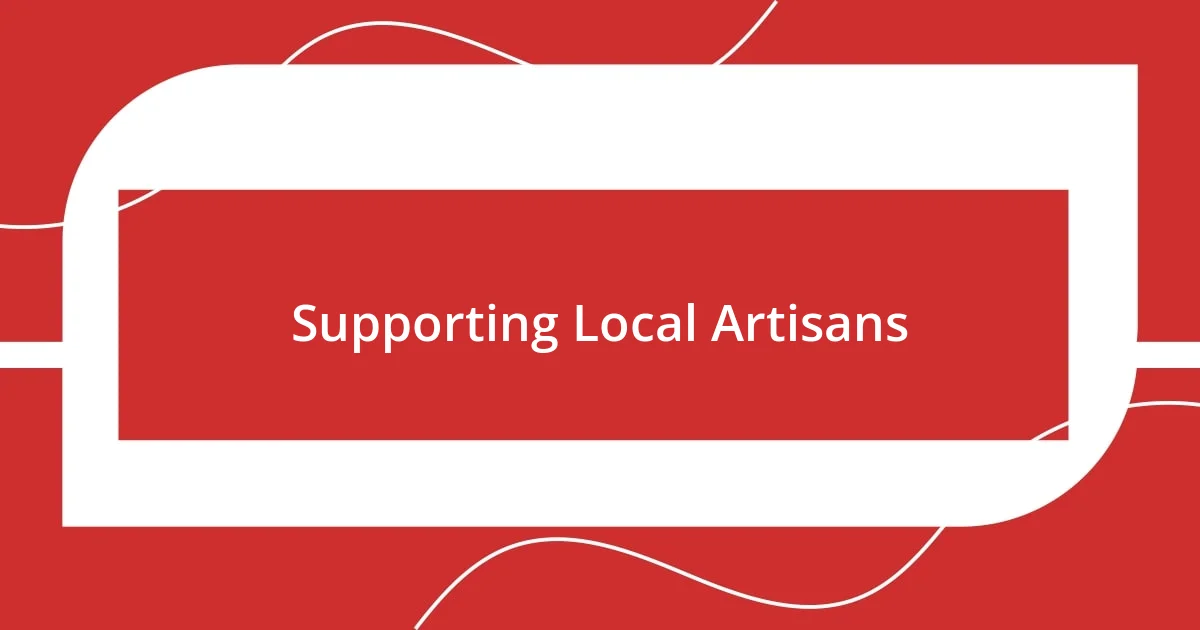
Supporting Local Artisans
Supporting local artisans is a vital aspect of the slow fashion movement that resonates deeply with me. I remember visiting a local craft fair where I met a textile artist who hand-dyed fabrics using natural materials. Listening to her passion and the stories behind each color made me appreciate the artistry and intention behind her work. How often do we pause to consider the hands that create our clothing?
When I choose to purchase from local artisans, I’m not just buying a product; I’m investing in a story and a community. Each piece feels more personal, as if I’m wearing a little piece of their creative journey. There was a time I bought a handmade leather bag from a local craftsman, and it felt like more than just an accessory; it felt like a connection to a vibrant local culture. Doesn’t it feel wonderful to know who made what you’re wearing?
Moreover, supporting local artisans promotes sustainable economies and reduces our environmental impact. I recall a conversation I had with a designer who uses recycled materials to create their pieces. By prioritizing their work, I felt I was part of something bigger—a movement towards a sustainable future that values craftsmanship over mass production. Isn’t it rewarding to make choices that align with our values and support those who care deeply about their craft?

Sharing Your Fashion Journey
Sharing your fashion journey is an intimate experience that connects us with our personal style and values. For me, reflecting on how my wardrobe evolved over the years reveals not only my changing tastes but also my growing awareness of fashion ethics. I still vividly remember the moment I decided to let go of fast fashion pieces that no longer felt right. How liberating it was to declutter my closet and choose only what truly resonates with my identity!
When I share my fashion choices with friends, it’s more than just swapping outfit ideas; it’s about exchanging stories and insights that inspire mindful consumption. I once hosted a small gathering where friends brought their favorite thrifted finds, and we shared the stories behind each piece. The laughter and appreciation we felt for each other’s unique journeys emphasized the beauty of slow fashion. Have you ever found joy in learning where your friends’ clothes came from?
Each piece in my wardrobe now carries a memory or intention, making getting dressed feel like a curated experience. I was touched when someone complimented my handmade scarf, and I was able to share how it was crafted by a talented local artist I met. That connection transformed a simple accessory into a storytelling moment that deepened my appreciation for both fashion and the community. Doesn’t it add value when our clothes come with a narrative of care and creativity?








